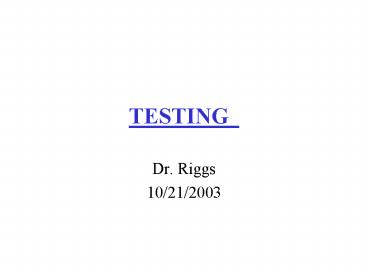TESTING - PowerPoint PPT Presentation
1 / 27
Title:
TESTING
Description:
Earlier detection = Lower cost to fix (398) Testing reveals presence (not ... 'Multiple condition' | Extended Brach Coverage' Cyclomatic number criterion ' ... – PowerPoint PPT presentation
Number of Views:38
Avg rating:3.0/5.0
Title: TESTING
1
TESTING
- Dr. Riggs
- 10/21/2003
2
Background
- Code errors 30-85/KLOC
- After testing 0.5-3 /KLOC
- Not much theory
- BUT
- Earlier detection gt Lower cost to fix (398)
- Testing reveals presence (not absence) of errors
3
Varieties of Testing
- Coverage Test all of x (reqs, lines)
- Fault-Based test on constructed faults
- Error-based test for common errors
- Black-box test from spec
- White box test from code
4
Test Objectives
- Determine
- Error human action
- Fault improper code
- Failure improper behavior
5
VV
- Verification complies with spec
- Built it right?
- Validation complies with requirements
- Right thing built?
6
Global View of Test Process
- Test Strategy
- Oracle
- System
- Comparator
- Output Failures
Cf. Figure 13.2 P 401
7
Test Adequacy Criteria
- defines tests required
- stop rule
- measure
- generator
- Linked to test strategy
- Coverage example (p402 code, p. 404 fig 13.3)
8
Fault Detection vs Confidence Building
- Fault Detection
- Partition of cases for test
- (complete ? no faults)
- Confidence in Reliability
- Load simulation
- Random testing
- Cleanroom
9
Fault Detection ? Prevention
- Phase models
- Demonstration check against spec
- Destruction check implementation for faults
- Life Cycle Models
- Evaluation detect req., design implementation
faults - Prevention Prevent req., deign implementation
faults
10
Testing in SW Life Cycle
- Determine test strategy
- Test requirements specification
- Generate functional test data
- Check consistency of design / req. s specs
- Evaluate software architecture
- Test design
- Generate structural and functional test data
- Execute tests
- Consistency of design implementation
- Test implementation
- Generate structural and functional test data
- Execute tests
- Repeat above as applies to change
- Req. Engr.
- Design
- Implementation
- Maintenance
11
Requirements
- Essential tests (Boehm)
- Completeness
- Consistency
- Feasibility
- Testability
- Likely errors (Poston)
- Missing info
- Unusable info
- Extra info
- Standard Formats (IEEE 830)
12
Design
- Criteria like reqs
- Likely faults like reqs
- Methods
- simulation, walkthroughs, inspections
- Standard IEEE 1016
13
Implementation
- Manual Techniques
- Code-inspection
- Stepwise abstraction
- Tool techniques
- Static Analysis of code
- Parsing
- Formal
- Dynamic Analysis of Code
- Execution
- Devices
- Drivers
- Data generators
- Stubs
14
Maintenance
- Retest-All
- Selective retest
- Regression test selection
- ???
15
VV Plannign Doc
- Waterfall
- IEEE Standard 1012
- IEEE 86a
16
Manual Test Techniques
- Static
- Reading
- Peer review
- ego-less programming
- Walkthroughs Inspections
- Moderator inspectors author
- Checklist of faults
- Test data as guide
- Specialized roles (fault sets) Parnas
17
Scenario-based Evaluation
- At design architecture phase
- (SAAM Software Architecture analysis Method)
- Choose scenarios (use cases)
- Select candidate Architectures
- Find support in architecture (direct/indirect)
- Find needed changes to architecture(s)
- high change for similar cases ? poor arch
- Overall evaluation
18
Correctness Proofs
- Formal techniques
- Floyd-Hoare
- P S Q
- Precondition
- Code
- Post-condition
- Very different from programming!
- Less different from programming
- Z, VDM, B, ASM etc
19
Stepwise Abstraction
- Example p 419
- Comment
- Loop Bottom
- (search ?bottom ?mid ?top)
- (found ?x ?mid)(search ?bottom)(search ?top)
- Loop Termination
- (found ?x ?mid) (search NULL)
- Abstraction
- (found ?x ?min(lt 1 ?mid ?n)) (not (? ?x ?))
20
Coverage-based techniques
- Cover x (lt 100) of
- Control-flow coverage
- Data flow coverage
- Requirements
- Graph model of requirements
21
Control Flow Coverage
- All-paths
- Exhaustive testing
- All-nodes
- Weak
- Branch coverage
- Effective (at branch) combinations of predicates
- All possible combinations
- Multiple condition Extended Brach Coverage
- Cyclomatic number criterion
- Linearly-independent paths
- All nodes, all connected, all paths, there is gt
1 unique edge
22
Data Flow Coverage
- Data item
- Defined(state) given a value in the state
- Alive(state) there is a flow from def to state
- Definition-clear Definition?Definition or ?
- Usages
- P use part of a Boolean
- C use part of calculation
- Strategies
- Degree of P/C uses
23
Requirements Spec Coverage
- Develop graph of requirements
- Assume 1 test per module (node)
- Apply some control-flow technique
- Problems
- Modularization may not be accurate for all data
24
Fault-Based Techniques
- Naïve Statistical Method
- Select errors, Seed code (N)
- Test code (m errors, m1 from N)
- Estimate errors (m-m1)N/m1
- Selecting faults
- Experience
- Fault exchange between groups
- Linear relation between early and late faults!
25
Mutation Testing
- Mutate program
- Replace
- constant ? constant, variable
- Variable?variable
- Type.operator?type.operator
- Insert unary operator
- Delete statement
- Better test set kills mutants faster (D/M)
- Assumptions
- Good code close to correct
- Simple faults ? complex faults
26
Error-based techniques
- Focus on error-prone points
- Requirements ? data partition by attributes
- Test from each partition all paths coverage
- ON points on sub-domain border
- OFF point just inside border
- Nx1 domain adequate N ONs gt 1 OFF
27
(No Transcript)































